Fertilize regularly during the growing season, especially when the trees are in bloom and growing their fruit. Cashew plants respond well to fertilizer and manure application. These compounds are applied to different stages of the plant. Let’s check out the best fertilizer for Cashew tree.
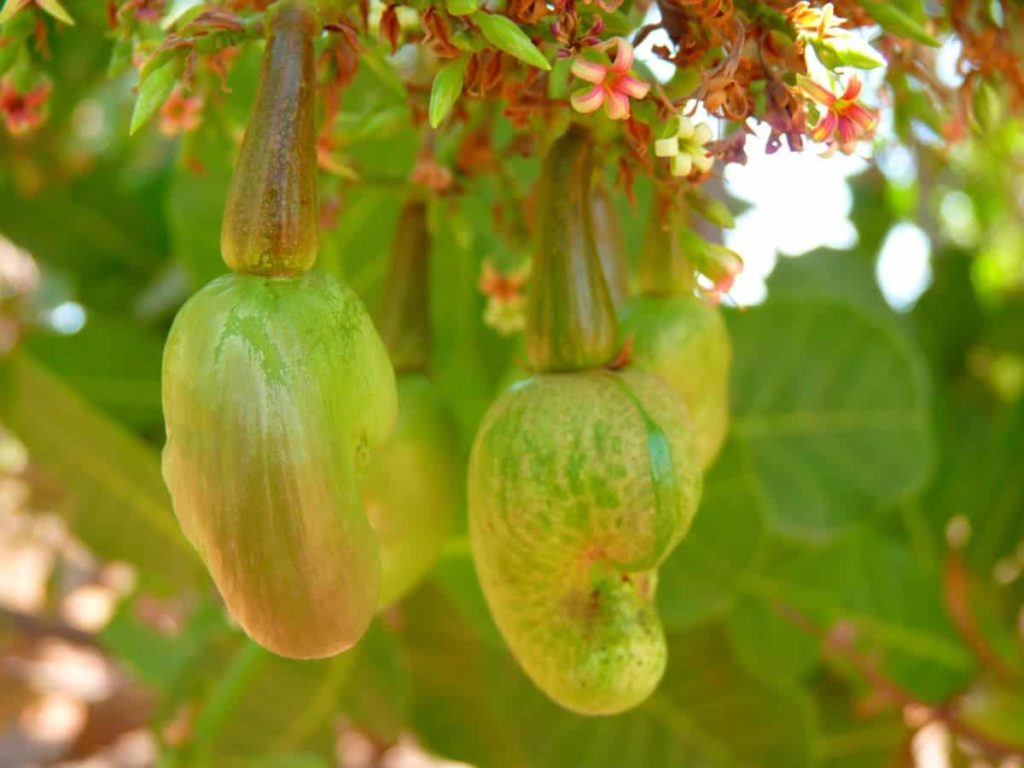
The fertilizer you use should contain nitrogen, phosphorus, and zinc. The amount you apply will depend on the size of the tree and the conditions under which it grows. You will usually need to fertilize your tree once every two months during the growing season. You can also apply compost or farmyard manure to the soil around the base of mature Cashew trees once a year.
NPK fertilizer application
From the point of view of the types of fertilization, the mixed application of N, P, and K increases the optimum yield followed by a single P application, and then an N and P mixed application. High levels of N can increase the flowering period, while high levels of P and K shorten the flowering period. In our country, the use of manures and fertilizers in the case of Cashews is very limited.
Adequate N: P: K ratio must be maintained in the soil for better yield. It is recommended to apply 10-15 kg of farmyard manure per plant to ensure proper organic matter in the soil. Applying N 600 grams, P 200 grams, and K 200 grams per plant per year can be recommended fertilizers for significantly increasing the nut tree per plant and increasing the total yield and kernel yield.
In case you miss this: Organic Cashew Production (Kaju) – Cultivation In India
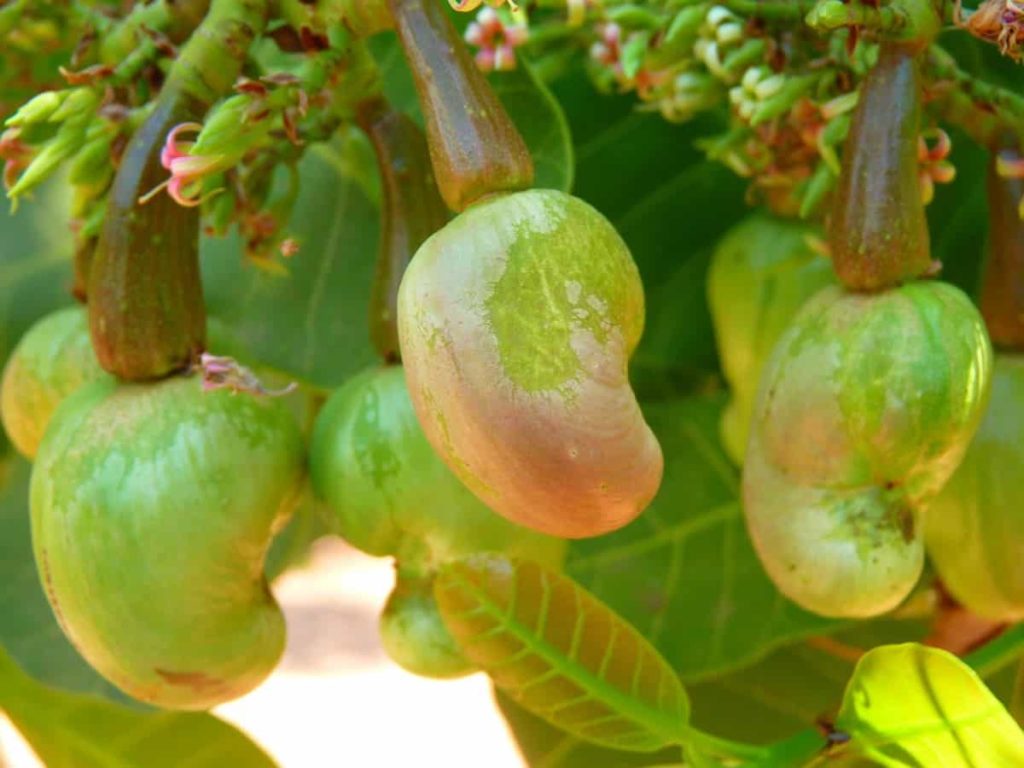
Ideal time for Cashew tree fertilizer application
Immediately after the cessation of heavy rains is the ideal time for fertilizer application in the Cashew crop. Though, the fertilizers should be applied in a circular trench along the drip line. Before applying fertilizers, make sure that the soil has adequate moisture. Fertilizers in Cashew should be applied after pre-monsoon (May-June) and post-monsoon (September-October) should be fed in two divided doses.
It should be done during the post-monsoon season (September-October) when there is adequate moisture in the soil. In sandy and laterite soils, fertilizer should be applied in a circular trench in soils of sloppy land and areas with high rainfall. In red loamy soils and low rainfed areas (east coast), fertilizer should be applied in round bands.
Method of fertilizer application
It is always advisable to use straight fertilizers instead of complex fertilizers for Cashew. The main reason for this is that the NPK’s recommended dose for Cashews is not available in any of the complex fertilizers currently available in the market. Fertilizer is to be applied after the end of heavy rains and after weeding and clearing the roots of individual trees.
The key to increasing fertilizer application efficiency is to adapt the timing of fertilizer application to the need for crop growth and the duration of more root activity. About 72% of all active Cashew roots live within 2 meters of the tree. Fertilizer can be applied to individual tree basins either in circular bands or in round trenches.
In case you miss this: Cashew Seed Germination, Period, Temperature, Process
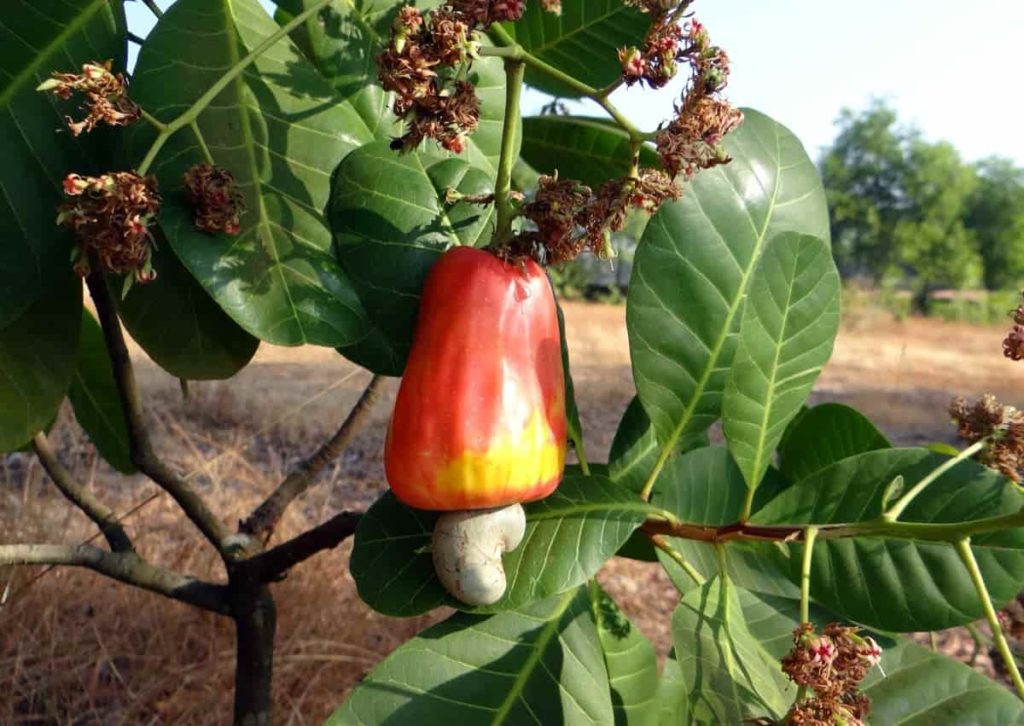
In sloping soils in lateral soils and areas with heavy rainfall, fertilizer should be placed in round trenches 25 cm wide and 15 cm deep, which are 0.5 meters, 0.7 meters, 1.0 meters, and 1.5 meters away from the trunk in the first, second, third and fourth year after planting, respectively. The trenches should be closed immediately after fertilization and it is better to apply green leaf mulch to increase the efficiency of fertilizer application by plants.
Instead of applying fertilizer twice a year, the frequency can be limited to once a year, which is compatible with the “flushing and early flowering phase”, which can save some application costs. Fertilizers should be applied only after weeding and clearing individual tree basins within a radius of 2.5 meters to avoid competition for nutrients from weeds.
Compost manure fertilizer for Cashew tree
Manure application in Cashews is not a regular practice in existing orchards in India, although the proper application of fertilizer may be the fastest way and a viable means of increasing Cashew productivity. However, most current Cashew growers do not fertilize Cashews, except for Cashew corporations or Cashew-growing state forest departments that own Cashew orchards. Due to its extensive root system, Cashews can get large amounts of nutrients from the soil and small farmers rarely fertilize the crop.
It has been estimated that the availability of moisture is in many cases more limited to Cashews than to nutrients. However, recent research results indicate that Cashews need regular fertilizer to ensure faster and higher yields from mature trees. Fertilizers and manures promote plant growth and promote the onset of flowering in young trees. In the absence of FYM, green manure can be used as an alternative.
Best Fertilizer for Cashew Tree, Sesbania, and Sunhemp are the green manure crops and these plants can be grown along the boundaries and between two rows of Cashews. The use of green manure increases the amount of organic matter in the soil. It also improves soil texture and helps reduce runoff and soil erosion. Wherever available, chicken manure can be used instead of FYM at the rate of 10 kg per tree per annum.
In case you miss this: Cashew Nut Farming Project Report, Cost and Profit
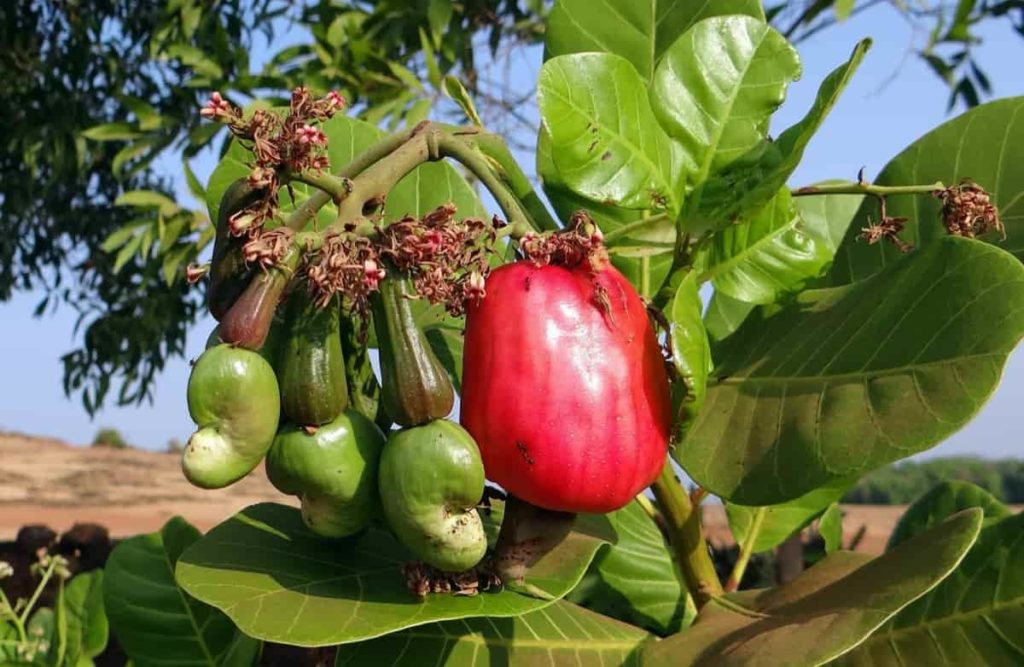
Nutrition management under organic farming in Cashew
Organic fertilizers
Organic fertilizers are essential during the early stages, preferably when planting in pits. Applying Cashew grafts after making pits and filling up with soil + organic matter such as farmyard manure, compost or cake is beneficial for strong growth and early growth in the early stages. It is recommended that young plants use well-decomposed farmyard manure or compost. If Cashew is being grown as an organic plant, then nutrients are provided in the form of oil cake, green leaf compost, vermicompost, poultry manure, etc.
For deciding yield, determining soil fertility and nutrient supply is one of the key factors. It has been reported that only 20% of the area under Cashew cultivation is nutritious. Although Cashew orchards are reported to produce 1.38 to 5.20 t ha-1 Cashew leaf litter biomass with reported composting efficiency of 65%, they have not been properly recycled in Cashew orchards. During the harvest season, leaf litter is removed to facilitate the picking of nuts. They can be burned during other periods.
In case you miss this: Cashew Farming; Planting, Care; Harvesting – A Full Guide
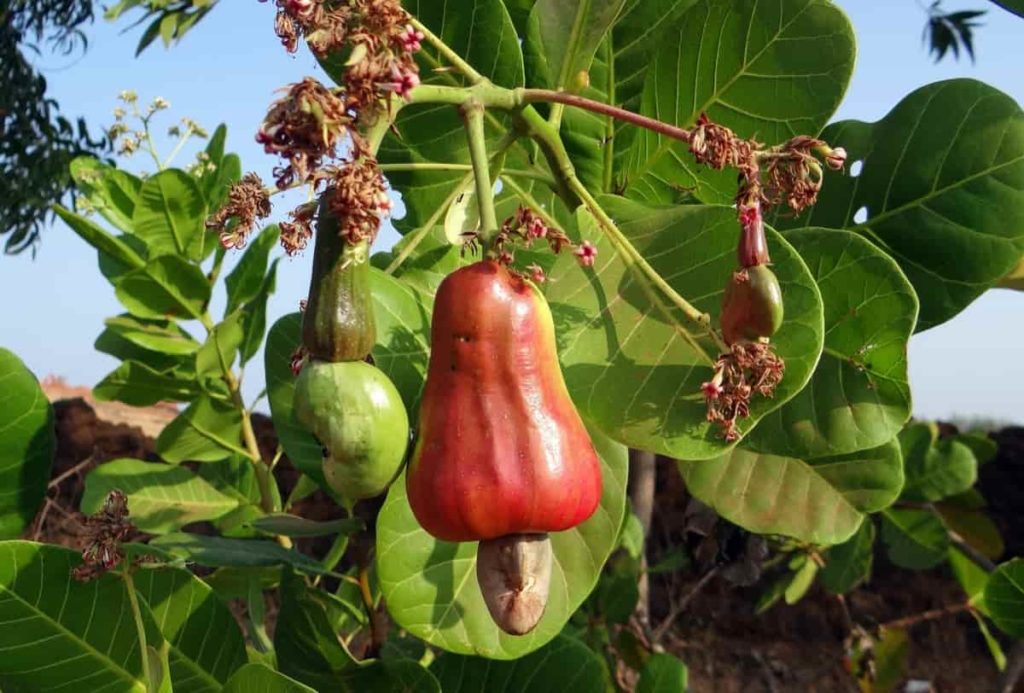
However, the prepared compost is applied to other crops such as Arecanut, Coconut, etc. These processes lead to soil nutrient deficiencies year after year. Although chemical fertilizers are an easy way to grow and increase productivity, some consumers nowadays prefer organic Cashews. In addition, there is growing concern about rising fertilizer prices due to government policies and environmental concerns.
Management of major nutrients
The recommended fertilizer is suitable for 80-100% canopy coverage, which is usually obtained during the first 6-8 years of planting in a high-density Cashew planting system. After a certain stage of the crop, the fall of Cashew fermenting biomass may lead to a reduction in the recommended amount of fertilizer per plant due to nutrient accumulation in the soil. It reiterates the need for site-specific nutrient management based on soil testing.
Nitrogen – Nitrogen (N) is an important component of nitrogen plants and due to increased mobility, symptoms of nitrogen deficiency always appear first in older leaves. The stem becomes thinner and the growth stops. The light sandy soils of the coastal region, where Cashews are mostly grown, are deficient in organic matter and low in nitrogen. The availability of nitrogen is also closely linked to the activity of soil microorganisms.
At low nitrogen, Cashew seedlings (2 years old) were noticeable with normal yellowing of old leaves which soon spread to smaller leaves. The leaves were also small. Nitrogen deficiency in Cashew seedlings became apparent 7 weeks after planting. The color of the leaves gradually changes from dark to light green and then to yellow, which coincides with stunted growth. In case of severe nitrogen deficiency, the plants die after 4 months.
In case you miss this: District Wise Crop Production in Maharashtra: Major Crops in Maharashtra
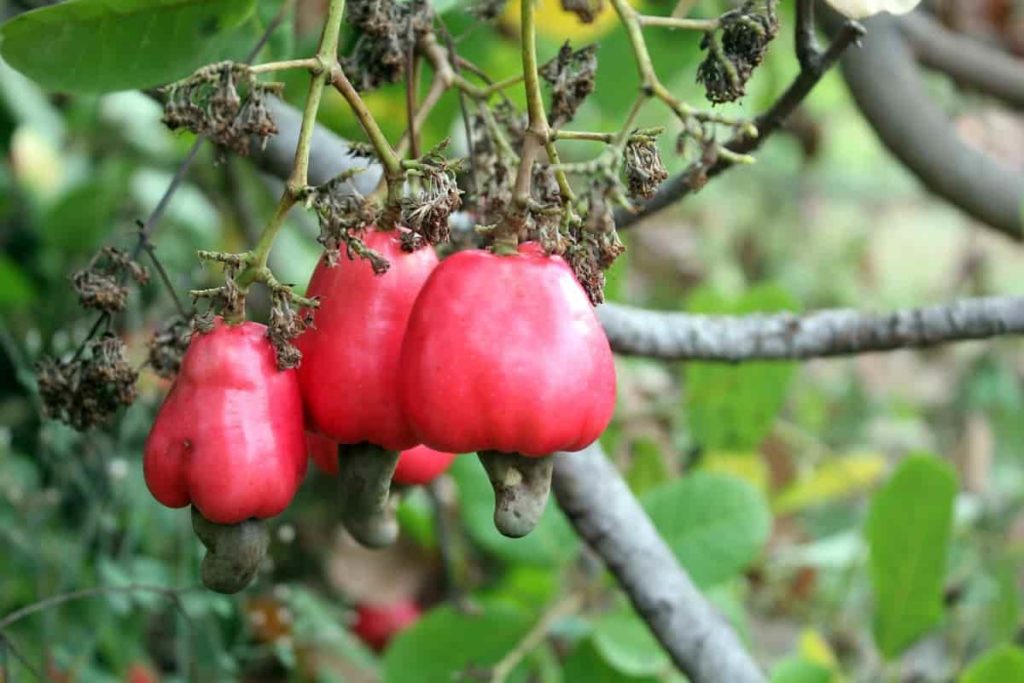
The amount of nitrogen in the twigs showed a very important positive relationship with plant girth and the height of seedlings. Cashews generally appear to be less demanding in their nutritional needs than many other plants. However, the use of nitrogen significantly affects the production of nuts. As nitrogen levels increase, the concentration of N, P, K, and Ca increases in all parts of the plant, but Mg (in the roots), S (in the stem), and Na (in the leaves) gradually decreases.
Phosphorus (P2O5)
Phosphate is also important in seed germination, metabolism of seedlings, rapid root growth, and seed maturation. Heavy soils have higher fixing power for phosphates. As a result of phosphate deficiency, the growth of pale green plants stops and the lower leaves of Cashew wither and fall off by the fifth month. Phosphate application is more effective when planting in pits or locally in the root zone.
Potassium (K2O)
Symptoms of potassium deficiency can occur in Cashew seeds within 2 months. The lower leaves turn yellow, starting at the apex and showing margins, necrosis. Symptoms spread rapidly from the bottom of the leaf to the top. While potassium is applied to overgrown Cashew trees, the K content was highest in the leaves 14 days after application. Usually, potassium deficiency occurs mostly on light sandy soils.
- Types of Pesticides Used in Agriculture: A Beginner’s Guide
- Economical Aquaculture: A Guide to Low-Budget Fish Farming
- 15 Common Planting Errors That Can Doom Your Fruit Trees
- How to Make Houseplants Bushy: Effective Tips and Ideas
- Innovative Strategies for Boosting Coconut Pollination and Yield
- Pollination Strategies for Maximum Pumpkin Yield
- The Complete Guide to Chicken Fattening: Strategies for Maximum Growth
- Natural Solutions for Tulip Problems: 100% Effective Remedies for Leaf and Bulb-Related Issues
- Revolutionizing Citrus Preservation: Towards a Healthier, Greener Future
- Natural Solutions for Peony Leaf and Flower Problems: 100% Effective Remedies
- Maximizing Profits with Avocado Contract Farming in India: A Comprehensive Guide
- Natural Solutions for Hydrangea Problems: 100% Effective Remedies for Leaf and Flowers
- The Ultimate Guide to Choosing the Perfect Foliage Friend: Bringing Life Indoors
- From Sunlight to Sustainability: 15 Ways to Use Solar Technology in Agriculture
- The Ultimate Guide to Dong Tao Chicken: Exploring from History to Raising
- The Eco-Friendly Makeover: How to Convert Your Unused Swimming Pool into a Fish Pond
- Mastering the Art of Delaware Chicken Farming: Essentials for Healthy Backyard Flocks
- 20 Best Homemade Fertilizers for Money Plant: DIY Recipes and Application Methods
- How to Craft a Comprehensive Free-Range Chicken Farming Business Plan
- Brighten Your Flock: Raising Easter Egger Chickens for Beauty and Bounty
- How to Optimize Your Poultry Egg Farm Business Plan with These Strategies
- Subsidy for Spirulina Cultivation: How Indian Government Schemes Encouraging Spirulina Farmers
- Ultimate Guide to Raising Dominique Chickens: Breeding, Feeding, Egg-Production, and Care
- Mastering the Art of Raising Jersey Giant Chickens: Care, Feeding, and More
- Ultimate Guide to Raising Legbar Chickens: Breeding, Farming Practices, Diet, Egg-Production
- How to Raise Welsummer Chickens: A Comprehensive Guide for Beginners
- How to Protect Indoor Plants in Winter: A Comprehensive Guide
- Ultimate Guide to Grow Bag Gardening: Tips, Tricks, and Planting Ideas for Urban Gardeners
- Guide to Lotus Cultivation: How to Propagate, Plant, Grow, Care, Cost, and Profit
- Agriculture Drone Subsidy Scheme: Government Kisan Subsidy, License, and How to Apply Online
- Ultimate Guide to Raising Araucana Chickens: Breed Profile, Farming Economics, Diet, and Care
- Bringing Hydroponics to Classroom: Importance, Benefits of Learning for School Students
- Ultimate Guide to Raising Polish Chickens: Breed Profile, Farming Economics, Diet, and Care
- Ultimate Guide to Raising Australorp Chickens: Profile, Farming Economics, Egg Production, Diet, and Care
- Silkie Chicken Farming: Raising Practices, Varieties, Egg Production, Diet, and Care
- Sussex Chicken Farming: Raising Practices, Varieties, Egg Production, Diet and Care